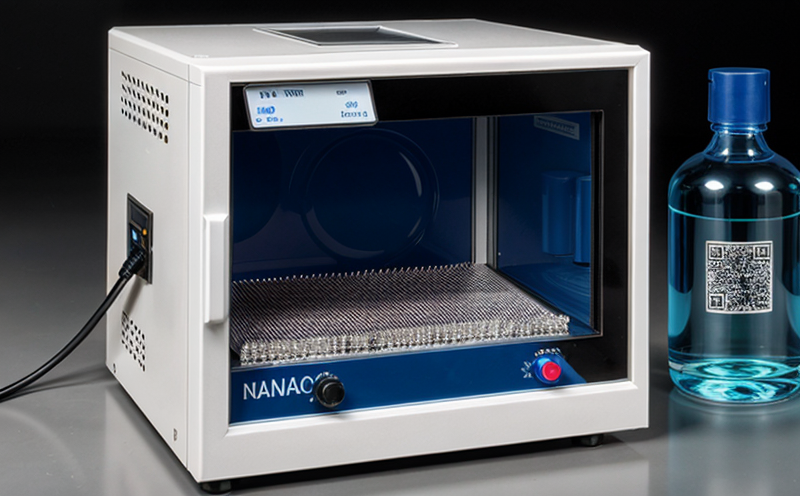ASTM E3171 Nanomaterial Stability Testing in Suspension
The ASTM E3171 standard provides a framework for the stability testing of nanomaterials in suspension. This service is particularly critical for sectors like pharmaceuticals, cosmetics, and environmental science where nano-sized particles can significantly impact product performance and safety.
Nanomaterials exhibit unique physical and chemical properties that are distinct from their bulk counterparts. In suspension, these materials can aggregate or settle out over time, affecting both the formulation stability of products and the health risks associated with exposure. ASTM E3171 addresses this challenge by offering a standardized method to assess nanomaterial stability under controlled conditions.
The testing process involves several critical steps. Initially, the nanomaterial sample is prepared according to specific protocols outlined in the standard. This preparation ensures that the sample accurately represents the material as it would be encountered in real-world applications. Once prepared, the sample is subjected to a series of stability tests designed to simulate various environmental conditions such as temperature, pH changes, and exposure to light.
Key instrumentation used in this testing includes dynamic light scattering (DLS) spectrometers, which measure particle size distribution over time, and zeta potential analyzers that assess the electrostatic charge on particles. These tools provide detailed insights into how nanomaterials behave under different conditions, offering valuable data for formulation development and regulatory compliance.
The ASTM E3171 process also includes rigorous analytical techniques to evaluate particle aggregation, sedimentation rates, and other relevant parameters. This comprehensive approach ensures that the test results are robust and reliable, providing stakeholders with confidence in the stability of their nanomaterial formulations.
Understanding the stability of nanomaterials is essential for ensuring product safety and efficacy. By adhering to ASTM E3171 standards, manufacturers can demonstrate compliance with international regulations and guidelines, thereby protecting both consumers and the environment.
Why It Matters
The importance of ASTM E3171 nanomaterial stability testing in suspension cannot be overstated. Nanoparticles are widely used in industries ranging from pharmaceuticals to electronics due to their unique properties. However, these same properties also make them prone to instability under certain conditions.
For instance, in the pharmaceutical sector, nano-sized drug particles need to remain stable throughout the product lifecycle. Any aggregation or breakdown could lead to reduced efficacy or even safety issues. Similarly, in cosmetics, nanomaterials are used for their skin penetration and delivery properties. Ensuring these materials remain intact is crucial for maintaining product performance.
Environmental considerations also play a vital role in stability testing. Nanoparticles released into the environment can have unpredictable effects on ecosystems. By conducting ASTM E3171 tests, manufacturers can assess potential risks associated with environmental exposure and mitigate them where necessary.
In addition to these practical applications, ASTM E3171 testing supports regulatory compliance. Many countries and regions require adherence to specific standards for the production and use of nanomaterials. By implementing ASTM E3171 methods, companies can ensure they meet these requirements, avoiding potential legal issues and maintaining a positive reputation.
The reliability of test results is paramount in this field. ASTM E3171 provides a standardized approach that ensures consistent and accurate measurements across different labs. This consistency builds trust among stakeholders and facilitates smoother collaboration between manufacturers, researchers, and regulatory bodies.
Customer Impact and Satisfaction
The impact of ASTM E3171 nanomaterial stability testing in suspension extends beyond compliance to direct benefits for customers. By ensuring the stability of nano-sized materials, this service helps companies deliver consistent product quality that meets or exceeds customer expectations.
For example, pharmaceutical companies can use these test results to optimize their formulation processes, leading to more effective and safer drug products. In cosmetics, stable nanomaterials enhance the efficacy of skincare formulations, providing consumers with better outcomes. Moreover, environmental impact assessments derived from ASTM E3171 testing allow for the development of less harmful products, appealing to eco-conscious customers.
Satisfaction among stakeholders is a key indicator of successful service delivery. Positive feedback from clients and partners underscores the value we bring through accurate and reliable testing. Our commitment to quality ensures that every test meets or exceeds industry standards, fostering long-term partnerships based on trust and mutual respect.
International Acceptance and Recognition
The ASTM E3171 standard has gained widespread acceptance across the globe due to its rigorous methodology and international relevance. Many countries incorporate this standard into their national regulations for nanomaterials, recognizing its importance in ensuring product safety and efficacy.
In pharmaceuticals, the European Medicines Agency (EMA) and the U.S. Food and Drug Administration (FDA) both recommend compliance with ASTM E3171 to assess nanomaterial stability. Similarly, in cosmetics, regulatory bodies like the U.S. Cosmetics Regulation and the EU's REACH regulations rely on ASTM standards for guidance.
The recognition of ASTM E3171 extends beyond government agencies. Leading industry associations such as the International Organization for Standardization (ISO) and the American Society for Testing and Materials (ASTM) continuously update this standard to reflect advancements in nanotechnology research.
By adhering to this internationally recognized standard, companies ensure their products meet global standards, opening up opportunities for international markets. The consistent application of ASTM E3171 across borders also enhances collaboration between multinational corporations and local manufacturers, promoting a unified approach to nanomaterial testing.





